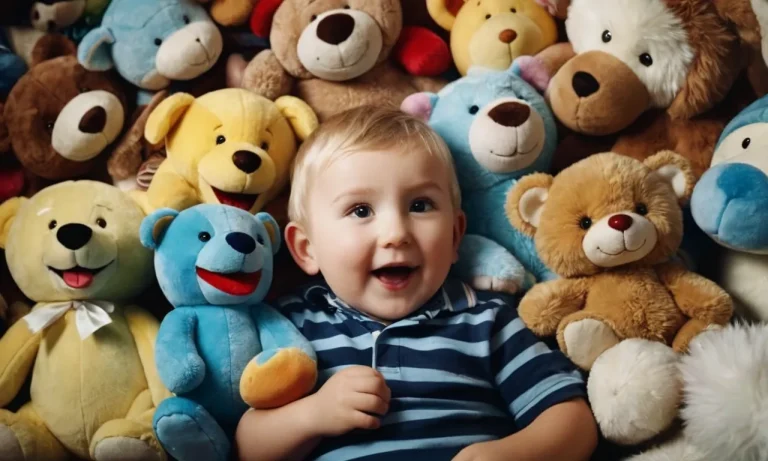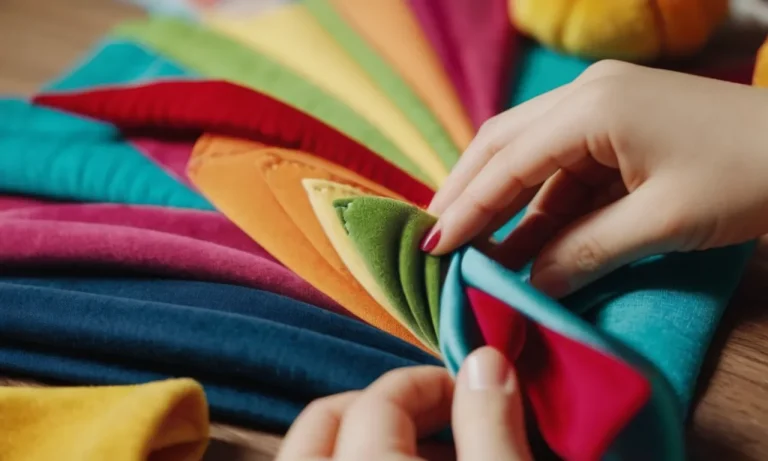Stuffed animals can provide comfort and nostalgia, but did you know some bears and plush toys have sold for outrageous sums? If you’ve ever wondered what the priciest stuffed animal is, read on.
The most expensive stuffed animal sold at auction is a Steiff Louis Vuitton bear that went for a record $2.1 million in 2000.
In this article, we’ll cover the background on record-setting high-end stuffed animals, find out what makes certain bears and plush so valuable, learn what the current most expensive stuffed toys are, and summarize the key details on the little-known world of luxury stuffed animal collecting.
Background on High-End Stuffed Animals
Teddy bear history and origins
The teddy bear has a storied history dating back to the early 20th century. According to legend, the first teddy bears were inspired by U.S. President Theodore “Teddy” Roosevelt’s 1902 hunting trip, where he refused to shoot a defenseless black bear cub that had been tied to a tree.
A political cartoon depicting the incident appeared in The Washington Post, capturing the public’s imagination. Soon after, a couple named Morris and Rose Michtom began selling toy bears they called “Teddy’s bears,” kickstarting the teddy bear craze.
By 1906, the Ideal Novelty and Toy Company was mass-producing teddy bears in the United States. These early teddy bears were made from mohair taken from Angora goats and became hugely popular as childhood companions. Their popularity endures to this day, over a century later.
Expensive teddy bear auctions over the years
As teddy bears grew in popularity as beloved children’s toys, rare antique specimens also began fetching high prices at auction:
- In 1994, an early 20th century Steiff teddy bear named “Teddy Girl” was sold at Christie’s auction house for a then-record $170,000.
- In 2000, a blonde mohair teddy bear made in Germany in 1905 was auctioned off by Sotheby’s for a new record price of $193,000.
- More recently in 2022, two Steiff teddy bears from the early 1900s, named “Daddy Bear” and “Baby Bear,” sold together at auction for $15,000, showing these toys continue to have incredible collectible value.
As the prices paid for rare, antique teddy bears indicate, these childhood toys hold an enduring nostalgic charm and historical significance that makes them highly prized by collectors.
Top luxury teddy bear brands
In addition to collectible antique teddy bears selling for sky-high auction prices, a number of modern high-end teddy bear artisans craft custom designed stuffed animals for an exclusive clientele:
| Brand | Notable Features | Price Range |
|---|---|---|
| Steiff | Iconic German brand making teddy bears since 1902 using premium alpaca wool. | $1,500 – $75,000 |
| Dean’s Rag Bears | Handmade in England using luxury fabrics like alpaca, cashmere and silk. | $1,500 – $50,000 |
| Middle Kingdom Workshop | Intricately designed heirloom bears made with Swarovski crystals and precious metals. | $10,000 – $1 million |
As the incredible prices of high-end stuffed animals from exclusive brands indicate, for the right collector or gift-giver, teddy bears remain more than child’s toys – they are precious objects and works of art worth investing in.
What Makes Some Stuffed Animals So Valuable
Stuffed animals can vary greatly in price depending on various factors. While most generic stuffed toys may only cost a few dollars, some exclusive and rare collectibles have sold for hundreds of thousands!
Materials such as Real Fur and Leather
Many high-end stuffed animals use premium materials like mink fur, fox fur, angora, cashmere, and fine leather. These luxurious materials significantly increase production costs. For example, the iconic Steiff Louis Vuitton teddy bear sold for over $2 million with its real mink fur and leather accessories.
Brand Names like Steiff, Hermès, and Louis Vuitton
Exclusive toy brands carry luxury brand recognition that collectors are willing to pay a premium for. Iconic German toymaker Steiff is renowned for its exceptional quality and craftsmanship. Its limited edition collectibles regularly fetch six-figure price tags.
Premium fashion houses like Hermès and Louis Vuitton also have signature plush toys that sell in the tens of thousands.
Rarity and Limited Editions
Scarcity greatly increases value. Many high-priced teddy bears are labeled as limited editions or one-of-a-kind custom pieces. For example, the record-holding Steiff Louis Vuitton bear was an exclusive one-off commission.
Limited edition boutique bears produced in small batches also appeal to collectors looking for rare finds. The fewer in circulation, the higher the market value!
Age and Condition
Antique and vintage stuffed animals in good condition fetch top dollar from collectors. Handmade early 20th century Steiff animals with buttons in ear can sell for tens of thousands. Even damaged vintage items can be valuable if rare enough.
Provenance and documentation proving authenticity also boosts worth.
| Stuffed Animal | Sale Price |
|---|---|
| Steiff Louis Vuitton Bear | $2.1 million |
| Early 1900s Steiff Elephant | $280,000 |
So in short, from the finest materials to exclusive branding, rarity, age and condition, many variables make some stuffed animals extra special and priceless! The most expensive tend to have that ‘perfect storm’ of luxury materials, iconic brands, sheer scarcity through limited editions or antiquity, and exceptional condition.
The Current Most Expensive Stuffed Animals
The record $2.1 million Steiff Louis Vuitton bear
In 2000, Steiff collaborated with luxury brand Louis Vuitton to create a unique teddy bear dressed in the iconic LV monogram pattern. Only 2000 of these exclusive bears were made. One of them sold at a Monaco auction in 2000 for the staggering price of $2.1 million, setting the record for the most expensive stuffed animal ever sold.
Other stuffed animals sold for over $100k
While no other plush toy has broke the $2 million mark, some have still commanded eye-watering prices:
- A rare 1905 Steiff circus elephant sold for $170,400 in 2015.
- A 1920s mechanical singing bird toy by the French company Roullet & Decamps went for $178,250 in 2012.
- In the same 2012 auction, an early 20th century French automaton or mechanical walking pig fetched $117,300.
These astronomical prices are mainly driven by the rarity, craftsmanship, and condition of early Steiff animals from the late 1800s and early 1900s. The company helped define plush toys as we know them today.
Honorable mentions: Expensive plush toys
While not strictly stuffed animals, some very pricey plush toys deserve a mention:
- A 1959 replica of Sputnik 1, the first satellite launched into space, sold for $2,882 in 2015.
- Some unique Pokémon plush toys have commanded five-figure price tags, like the 6-foot long sleeping Snorlax which fetched $15,000.
These demonstrate collectors’ willingness to pay big money for rare and novelty plush items, even if they are not traditional “stuffed animals”.
In the world of plush collectibles, the sky’s the limit for one-of-a-kind specimens in good condition. Record-setting Steiff teddies have long ruled the roost. But unique toys from other brands also prove prized quarry for eager collectors.
Key Takeaways on Pricy Stuffed Animal Collecting
Why people collect high-end stuffed animals
High-end stuffed animals, also known as artist teddy bears, are popular among collectors for various reasons. Some see them as an investment opportunity since limited edition pieces can appreciate greatly in value over time.
Others enjoy them for the exceptional craftsmanship and attention to detail that goes into creating them. Luxury stuffed animals use high-quality materials like alpaca fur or Swarovski crystal eyes, with some pieces taking hundreds of hours to handmake.
For many collectors, there is also an emotional attachment and enjoyment in owning special stuffed animals, similar to how some people collect fine art. Part of the appeal lies in supporting the artisans and small businesses who make these bears.
As one collector put it: “There’s just something magical about a teddy bear that’s made with care and feels like your childhood friend.”
How to find and buy luxury stuffed animals
You can discover high-end stuffed animal artists at specialty teddy bear shows, online marketplaces like Etsy, or through collector communities. Before purchasing, research artist reputations, check credentials like ABA or TBAA membership, and read third-party reviews.
When attending shows in-person, carefully inspect bears for quality and ask questions about materials and techniques.
Pricing varies greatly, but expect to invest at least $500+ for a quality handmade bear. Limited editions numbered under 100, or 1/1 custom pieces, fetch the highest values. Be prepared to pay premium prices for exotic materials like alpaca fur or Swarovski crystals.
When buying online, authenticate artist signatures and COAs. Use trusted escrow services for large transactions.
| Places to Buy | Things to Check |
| Specialty teddy bear shows | Artist reputation and credentials |
| Online marketplaces like Etsy | ABA, TBAA, or guild membership |
| Collector forums and groups | Reviews from other collectors |
| Artist websites or auctions | COAs, signatures, authenticity |
Is investing in expensive teddy bears worthwhile?
Collecting high-end stuffed animals can provide enjoyment and potentially grow in value over decades. However, there are risks too. Trends change, new artists emerge, and demand for vintage pieces can drop.
Conduct research before investing significant money into stuffed animals as you may not recoup the costs. Focus more on the intrinsic rewards of collecting beautiful, handmade pieces.
In the past 10 years, the average sale price for top-tier Steiff teddy bears has risen 14%, comparable to returns on stocks and bonds. Yet for every coveted “Charlie Bear,” there are lesser-known artists that don’t appreciate as well.
Prioritize your own interests first, and view high returns as an added possible bonus down the road.
Conclusion
While stuffed animals are usually seen as childhood playthings, the world of high-end teddy bear collecting reveals an unexpected reality where some bears sell for over $1 million.
From special Steiff limited editions to bejeweled plush toys, luxury stuffed animals can provide their owners comfort, nostalgia, status symbols, and even financial investments.
While most people won’t be able to justify spending millions on a teddy bear, learning about record-breaking plush and the stories behind these exclusive stuffed animals can still be fascinating.







